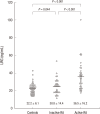Usefulness of serum leucine-rich alpha-2 glycoprotein as a disease activity biomarker in patients with rheumatoid arthritis
- PMID: 25246736
- PMCID: PMC4168171
- DOI: 10.3346/jkms.2014.29.9.1199
Usefulness of serum leucine-rich alpha-2 glycoprotein as a disease activity biomarker in patients with rheumatoid arthritis
Abstract
Our study aimed to investigate whether serum leucine-rich alpha-2-glycoprotein (LRG) levels are elevated in patients with rheumatoid arthritis (RA). In addition, we assessed their correlation with disease activity parameters and pro-inflammatory cytokine, tumor necrosis factor-α (TNF-α). Our study included 69 patients with RA and 48 age- and sex-matched healthy controls. Serum concentrations of TNF-α and LRG were determined by enzyme-linked immunosorbent assay. Serum LRG concentrations were significantly elevated in patients with RA compared with those in healthy controls (30.8 ± 14.4 vs. 22.2 ± 6.1 ng/mL; P<0.001). In patients with RA, serum LRG levels were found to be correlated with disease activity score 28 (DAS28), erythrocyte sedimentation rate, and C-reactive protein levels (γ=0.671; γ=0.612; and γ=0.601, P<0.001, respectively), but not with serum TNF-α levels. Serum LRG levels in patients with an active disease status (DAS28≥2.6) were significantly higher than those in remission (DAS28<2.6) (36.45 ± 14.36 vs. 24.63 ± 8.81 ng/mL; P<0.001). Our findings suggest that serum LRG could contribute to the inflammatory process independent of TNF-α and it may be a novel biomarker for assessing inflammatory activity in patients with RA.
Keywords: Arthritis, Rheumatoid; Disease Activity; Leucine-Rich Alpha-2-Glycoprotein; Tumor Necrosis Factor-alpha.
Conflict of interest statement
The authors have no conflicts of interest to disclose.
Figures




References
MeSH terms
Substances
LinkOut - more resources
Full Text Sources
Other Literature Sources
Medical
Research Materials
Miscellaneous

